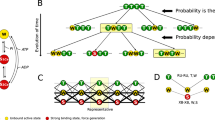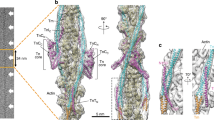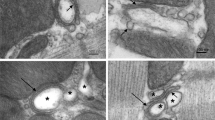Abstract
THE importance of calcium ions in the contraction mechanism of skeletal and cardiac muscle has been established on the basis of previous work1–15. Calcium seems to be stored in the sarcoplasmic reticulum and plays a critical part in coupling excitation with contraction when released into the sarcoplasm of these tissues after depolarization of the membrane. The exact way in which calcium performs this function is not clear, and, furthermore, calcium in cardiac tissue is divided into at least two components by kinetic studies with calcium-45 (refs. 16–19). This communication presents evidence for the applicability of kinetic analysis to the contraction process in cardiac tissue.
This is a preview of subscription content, access via your institution
Access options
Subscribe to this journal
Receive 51 print issues and online access
$199.00 per year
only $3.90 per issue
Buy this article
- Purchase on Springer Link
- Instant access to full article PDF
Prices may be subject to local taxes which are calculated during checkout
Similar content being viewed by others
References
Heilbrunn, L. V., and Wiercinski, F. J., J. Cell. Comp. Physiol., 29, 15 (1947).
Niedergerke, R., J. Physiol., 134, 569, 584 (1956).
Niedergerke, R., J. Physiol., 138, 506 (1957).
Niedergerke, R., and Harris, E. J., Nature, 179, 1068 (1957).
Niedergerke, R., and Lüttgau, H. C., Nature, 179, 1066 (1957).
Lüttgau, H. C., and Niedergerke, R., J. Physiol., 143, 486 (1958).
Frank, G. B., J. Physiol., 151, 518 (1960).
Weber, A., and Winicur, S., J. Biol. Chem., 236, 3198 (1961).
Sandow, A., Pharmacol. Rev., 17, 265 (1965).
Bianchi, C. P., and Shanes, A. M., J. Cell. Comp. Physiol., 56, 67 (1960).
Winegrad, S., J. Gen. Physiol., 48, 455 (1965).
Locke, F. A., and Rosenheim, O. T., J. Physiol., 36, 213 (1907).
Mines, G. R., J. Physiol., 46, 188 (1913).
Loewi, O., J. Pharmacol., 114, 90 (1955).
Winegrad, S., Circulation, 24, 523 (1961).
Winegrad, S., and Shanes, A., J. Gen. Physiol., 45, 371 (1962).
Sekul, A. A., and Holland, W. C., Amer. J. Physiol., 197, 752 (1959).
Langer, G. A., Circulat. Res., 15, 393 (1964).
Langer, G. A., Circulat. Res., 17 (1965).
Author information
Authors and Affiliations
Rights and permissions
About this article
Cite this article
DECARO, T. Correlation between Kinetically Defined Calcium Compartments and Contractile Response in Rabbit Atrium. Nature 215, 1182–1183 (1967). https://doi.org/10.1038/2151182a0
Received:
Issue Date:
DOI: https://doi.org/10.1038/2151182a0
Comments
By submitting a comment you agree to abide by our Terms and Community Guidelines. If you find something abusive or that does not comply with our terms or guidelines please flag it as inappropriate.



